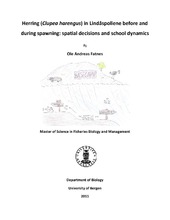| dc.description.abstract | Abstract This study reports on the school dynamics of a self-sustained local population of Atlantic herring (Clupea harengus) in Lindåspollene, south-western Norway, during pre-spawning and spawning, observed over a period of four years (2007-2010) by means of hydroacoustics. The school depth, horizontal and vertical extents and acoustic backscattering density were determined and used for estimation of school packing densities. The biological state of the herring and its gadoid predators were investigated by gillnet and tangling net samples, while the hydrographical conditions were recorded by means of CTD profiling. In all four years the adult herring were predominantly confined to a single school within a small geographical area (7000 m2), indicating strong site fidelity during the spawning process. The prespawning site, which was characterized by a 25-40 m deep trench connecting directly to the deepest part a basin, was located close to historical spawning grounds. During the pre-spawning period the herring remained in the pelagic environment while maturing, increasing the distance to the bottom in the presence of gadoid predators. The school occupied deeper waters near the bottom as spawning commenced and stayed there for a period of at least 9 and 48 days in 2009 and 2010. This suggests that the overall predation pressure from demersal fish was relatively low and that the duration of spawning was long compared to that of Norwegian spring spawning herring, which was supported by biological samples of herring. In 2009 a group of herring remained in the pelagic for at least 6 days as the main school moved to the bottom, indicating conflicting motivations between early pre-spawners and ripening individuals. The school packing density increased as spawning commenced, which could reflect increased vigilance while staying at the bottom, the home range of demersal predators such as cod. The school dynamic turbulence was lowest in the early pre-spawning period, highest in the late pre-spawning and early spawning period, before decreasing again in the late spawning period. These dynamic features could reflect conflicting interests of ripe individuals attracted to the bottom and pre-spawners preferring to remain in the pelagic prior to spawning. Similar conflicts could appear between individuals with a motivation to migrate to the spawning grounds and individuals that prefer to stay near the shelter of the deeper basin. The herring school dynamics in the pre-spawning and spawning periods persisted over the four study years even though some aspects of the behaviour changed markedly in 2010. The spawning processes 4 within the small system in Lindåspollene closely resemble those of the highly migratory Norwegian Spring spawning herring stock, although the processes take place within a very small area and in slow motion', demonstrating that small ecosystems like Lindåspollene may be a representative and a cost effective way of studying marine ecosystem processes. | en_US |
